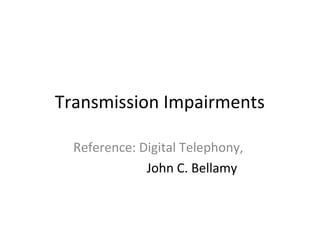Transmission impairments
•Download as PPT, PDF•
5 likes•7,289 views
This document discusses various types of transmission impairments including attenuation, distortion, and noise. Attenuation is the reduction of signal strength during transmission, while distortion alters the original signal shape. There are different types of distortion such as amplitude, delay, and frequency distortion. Noise refers to random electrical signals that interfere with reception, and can come from internal or external sources. Signal-to-noise ratio and noise figure are discussed as ways to measure noise levels relative to signals.
Report
Share
Report
Share

Recommended
Recommended
More Related Content
What's hot
What's hot (20)
Multiple access techniques for wireless communication

Multiple access techniques for wireless communication
Viewers also liked
Viewers also liked (6)
Similar to Transmission impairments
Similar to Transmission impairments (20)
More from avocado1111
More from avocado1111 (20)
Instant Power Supply ( IPS) System with Load Priority 

Instant Power Supply ( IPS) System with Load Priority
Recently uploaded
Mehran University Newsletter is a Quarterly Publication from Public Relations OfficeMehran University Newsletter Vol-X, Issue-I, 2024

Mehran University Newsletter Vol-X, Issue-I, 2024Mehran University of Engineering & Technology, Jamshoro
Recently uploaded (20)
Food safety_Challenges food safety laboratories_.pdf

Food safety_Challenges food safety laboratories_.pdf
HMCS Vancouver Pre-Deployment Brief - May 2024 (Web Version).pptx

HMCS Vancouver Pre-Deployment Brief - May 2024 (Web Version).pptx
UGC NET Paper 1 Mathematical Reasoning & Aptitude.pdf

UGC NET Paper 1 Mathematical Reasoning & Aptitude.pdf
ICT Role in 21st Century Education & its Challenges.pptx

ICT Role in 21st Century Education & its Challenges.pptx
HMCS Max Bernays Pre-Deployment Brief (May 2024).pptx

HMCS Max Bernays Pre-Deployment Brief (May 2024).pptx
Interdisciplinary_Insights_Data_Collection_Methods.pptx

Interdisciplinary_Insights_Data_Collection_Methods.pptx
ICT role in 21st century education and it's challenges.

ICT role in 21st century education and it's challenges.
Sensory_Experience_and_Emotional_Resonance_in_Gabriel_Okaras_The_Piano_and_Th...

Sensory_Experience_and_Emotional_Resonance_in_Gabriel_Okaras_The_Piano_and_Th...
Transmission impairments
- 1. Transmission Impairments Reference: Digital Telephony, John C. Bellamy
- 2. Attenuation: • Attenuation affects the propagation of waves and signals in electrical circuits, in optical fibers, as well as in air (radio waves). • Attenuation is reduction of signal strength during transmission. Attenuation is the opposite of amplification, and is normal when a signal is sent from one point to another. If the signal attenuates too much, it becomes unintelligible, which is why most networks require repeaters at regular intervals. Attenuation is measured in decibels. • Naturally, attenuation happens exponentially with the travelled distance.
- 3. Distortion • Distortion is known as the alternation of the original signal. This may happen due to the properties of the medium. There are many types of distortion such as amplitude distortion, harmonic distortion, and phase distortion. For electromagnetic waves polarization distortions also occurs. When the distortion occurs, shape of the waveform is changed. • For example, amplitude distortion happens if all the parts of the signals are not equally amplified. This happens in wireless transmissions because the medium get changed by the time. The receivers should be able to identify these distortions.
- 4. Distortion
- 5. Distortion Types: • Amplitude distortion • Delay / Phase Distortion • Frequency related distortion
- 6. Difference between attenuation and distortion 1. Although scaled down in amplitude, shape of waveform does not change in attenuation unlike in distortion. 2. Removal of the effects of attenuation is easier than a removing the effects distortion. 3. If the attenuation happens in different amounts for the different parts of the signal, it is a distortion.
- 8. Noise The random and unpredicted electrical signal (coming from both internal or external portion of the system) which interfere the reception of actual required signal is called- noise. Noise can be characterized by statistical parameter such as averaged/ squared noise, current/ voltage etc.
- 10. A receiver has an input signal power of l.2µW. The noise power is 0.80µW. What is the signal to noise ratio? • Signal to Noise Ratio = 10 Log (1.2/0.8) = 10 log 1.5 = 10 (0.176) = 1.76 dB
- 11. Noise figure I/P O/P where SNRin and SNRout are the input and output signal-to-noise ratios Comm Device
- 12. Noise-equivalent temperature It is a reference measurement between a minimum noise level due to thermal noise and total (ext.+ int.) noise. Teq= To (F-1)
- 13. Classification of Noise • External noises, i.e. noise whose sources are external – Atmospheric noises – Extraterrestrial noises – Man-made noises or industrial noises.
- 14. • Internal noise in communication, i.e. noises which get, generated within the receiver or communication system. – Thermal noise or white noise or Johnson noise – Shot noise. – Transit time noise - Miscellaneous internal noise